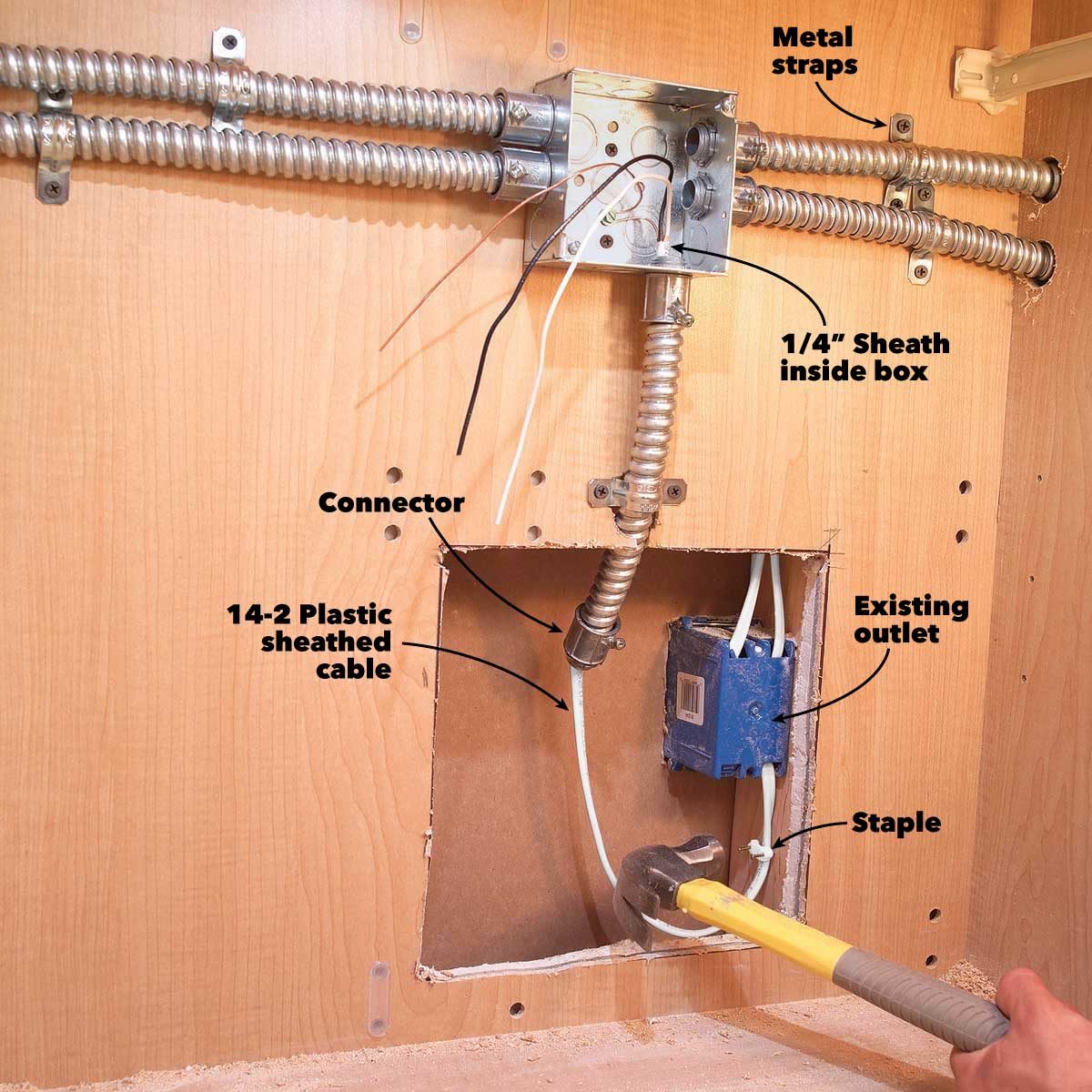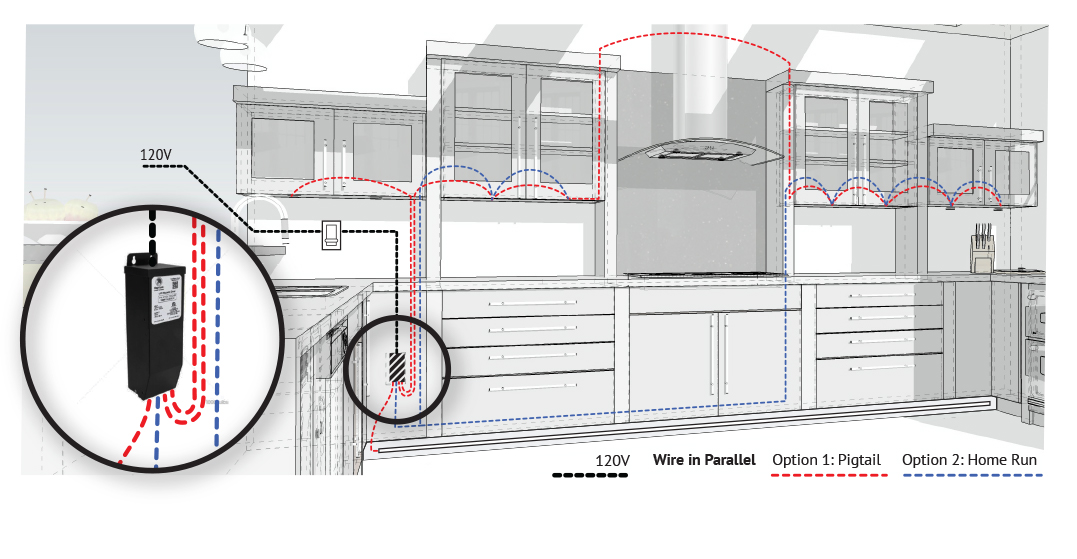Understanding LED Under Cabinet Lighting Wiring

Let’s dive into the electrical world of under cabinet lighting. We’ll explore the basics of electrical circuits, the different wiring configurations, and the components that make up these systems. Get ready to shine a light on the inner workings of your kitchen or bathroom!
Electrical Circuits: The Foundation of LED Under Cabinet Lighting
LED under cabinet lighting, like any electrical system, relies on a basic circuit. A circuit is a closed loop that allows electricity to flow from a power source, through a load (like the LED strip), and back to the source. This flow of electricity creates the light we see.
Types of Wiring Configurations for LED Under Cabinet Lighting
Different wiring configurations offer varying levels of flexibility, installation complexity, and cost. Here’s a breakdown of the common types:
- Hardwired: This involves directly connecting the LED strip to the electrical wiring in your home, typically through a junction box. It’s the most permanent option, offering reliable power and a clean, integrated look.
- Plug-in: This uses a standard electrical outlet to power the LED strip. It’s a convenient and flexible option, allowing for easy installation and relocation.
- Battery-powered: These systems use batteries to power the LED strip, offering portability and independence from electrical outlets. They are ideal for temporary installations or areas without easy access to power.
Components of an LED Under Cabinet Lighting Wiring Diagram
Understanding the components of a wiring diagram is crucial for successful installation and troubleshooting. Here’s a breakdown of the key elements:
- Wires: These carry the electrical current from the power source to the LED strip. They are typically insulated to prevent shocks and are color-coded for easy identification.
- Switches: These control the flow of electricity to the LED strip, allowing you to turn the lights on and off. They can be wall-mounted, remote-controlled, or integrated into the LED strip itself.
- Transformers: These convert the household voltage (typically 120V) to a lower voltage (usually 12V or 24V) suitable for powering the LED strip. They ensure safe and efficient operation.
- Connectors: These connect the different components of the wiring system, such as the LED strip to the transformer or the switch to the wires. They ensure a secure and reliable connection.
Comparing Wiring Configurations: Pros and Cons
| Configuration | Pros | Cons |
|---|---|---|
| Hardwired | Reliable power, clean installation, permanent | Requires professional installation, less flexible, higher initial cost |
| Plug-in | Easy installation, flexible placement, affordable | Limited power output, may require an outlet, less permanent |
| Battery-powered | Portable, no wiring required, convenient for temporary installations | Limited run time, requires battery replacement, lower light output |
Designing and Planning the Wiring Diagram

Planning the wiring diagram for your under cabinet lighting is crucial for a successful installation. It ensures a safe and efficient setup that meets your lighting needs and aesthetic preferences.
Factors to Consider When Planning the Wiring Diagram
Here are some important factors to consider when planning your wiring diagram:
- Size of the Space: Determine the length of the cabinets you want to illuminate. This will help you decide the number of light strips and the overall wiring length.
- Desired Brightness: Consider the level of brightness you need for your kitchen. This will influence the number of LED lights and their wattage. For example, if you want a bright, task-oriented lighting, you might need more lights than for a soft ambient glow.
- Aesthetic Preferences: Think about the style of your kitchen and how you want the lighting to look. Do you prefer a sleek, minimalist look or something more traditional? This will help you choose the type of light fixtures, wiring method, and switch placement.
- Power Source: Identify the available power source for your under cabinet lighting. You can either tap into an existing electrical outlet or install a dedicated circuit. This will impact the wiring method and the location of the switch.
- Switch Location: Determine the most convenient location for the switch. This could be near the countertop, a nearby wall, or even a remote control option for added convenience.
Sample Wiring Diagram, Led under cabinet lighting wiring diagram
Here’s a sample wiring diagram for a typical kitchen under cabinet lighting setup:
- Power Source: A standard 120V electrical outlet.
- Switch: A wall-mounted switch located near the countertop.
- Wiring Path: The wiring runs from the outlet to the switch, then to the LED light strips.
- Light Strips: Two 12V LED light strips, each covering half of the under-cabinet space.
- Transformer: A 12V transformer converts the 120V AC power to 12V DC for the LED light strips.
- Connectors: Use wire connectors to connect the wires from the switch, transformer, and light strips.
Essential Tools and Materials
Here’s a checklist of essential tools and materials needed for installing LED under cabinet lighting:
- Wire Strippers: For stripping the insulation off the wires.
- Wire Cutters: For cutting wires to the desired length.
- Screwdriver: For attaching the switch, transformer, and light strips.
- Voltage Tester: To ensure that the wiring is properly connected and the power is off before working on the circuit.
- Wire Connectors: For connecting the wires from the switch, transformer, and light strips.
- Electrical Tape: For insulating the wire connections.
- LED Light Strips: Choose the desired length and brightness.
- Transformer: To convert the 120V AC power to 12V DC for the LED light strips.
- Switch: Choose a suitable switch for your application.
- Wire: Use appropriate gauge wire for the electrical current requirements of the LED light strips.
Installing and Troubleshooting LED Under Cabinet Lighting: Led Under Cabinet Lighting Wiring Diagram

Now that you’ve got your wiring diagram sorted, it’s time to get those LEDs shining under your cabinets! This section will guide you through the installation process step-by-step, covering both hardwired and plug-in configurations. We’ll also tackle common wiring issues and how to troubleshoot them, ensuring a smooth and successful installation.
Installing LED Under Cabinet Lighting
Installing LED under cabinet lighting is a fairly straightforward process, but it’s important to prioritize safety and follow proper procedures. Here’s a breakdown of the installation steps for both hardwired and plug-in configurations:
Hardwired Installation
- Turn off the power. Before you start, always turn off the power to the circuit you’ll be working on. This is crucial for your safety and prevents electrical shocks.
- Mount the LED strip. Use the included mounting clips or adhesive tape to securely attach the LED strip to the underside of your cabinets. Ensure the strip is evenly spaced and positioned according to your design.
- Connect the wiring. Connect the LED strip to the power source. For hardwired installations, this typically involves connecting the strip to a junction box. Use wire connectors to secure the connections, ensuring they are tight and secure.
- Test the lights. Once everything is connected, turn the power back on and test the lights. Make sure they are working properly and that the brightness is to your liking.
- Secure the wiring. Neatly secure any loose wiring with cable ties or clamps. This helps maintain a clean and organized installation.
Plug-in Installation
- Connect the LED strip to the power adapter. Plug one end of the LED strip into the power adapter. Ensure the connections are secure and tight.
- Mount the LED strip. Use the included mounting clips or adhesive tape to securely attach the LED strip to the underside of your cabinets. Ensure the strip is evenly spaced and positioned according to your design.
- Plug in the power adapter. Plug the power adapter into a standard wall outlet.
- Test the lights. Turn on the power adapter and test the lights. Ensure they are working properly and that the brightness is to your liking.
- Secure the wiring. Neatly secure any loose wiring with cable ties or clamps. This helps maintain a clean and organized installation.
Troubleshooting LED Under Cabinet Lighting
Even with careful installation, sometimes issues can arise. Here’s a table outlining common wiring issues and their troubleshooting solutions:
| Issue | Solution |
|---|---|
| Lights not working | – Check if the power is turned on. – Verify that the connections are secure and tight. – Inspect the LED strip for any damage or breaks. – Test the power adapter (if applicable) by plugging it into a different outlet. |
| Dim or flickering lights | – Ensure the voltage is correct for the LED strip. – Check for loose connections. – Inspect the LED strip for any damage or breaks. – Try replacing the power adapter (if applicable). |
| Uneven brightness | – Make sure the LED strip is properly connected to the power source. – Check for any kinks or bends in the LED strip. – Inspect the LED strip for any damage or breaks. |
Connecting Wires and Components
Connecting wires and components correctly is crucial for both electrical safety and optimal performance. Here are some important tips to keep in mind:
- Use the correct wire gauge. The wire gauge should be appropriate for the current load of the LED strip. Refer to the manufacturer’s specifications for guidance.
- Strip wires properly. When stripping wires, ensure you remove just enough insulation to make a secure connection. Avoid damaging the wire itself.
- Use wire connectors. Wire connectors, also known as wire nuts, are essential for making secure and reliable connections. Always use connectors that are rated for the appropriate voltage and amperage.
- Secure connections. Ensure all connections are tight and secure. Loose connections can lead to overheating, damage, and even fire hazards.
- Avoid overloading circuits. Do not connect too many LED strips to a single circuit. Overloading can cause the circuit to overheat and potentially lead to a fire.
Potential Problems During Installation
While LED under cabinet lighting is generally a straightforward installation, some potential problems might arise. Be aware of these common issues:
- Faulty wiring. Incorrect wiring or loose connections can cause a variety of problems, including lights not working, flickering, or overheating.
- Incorrect voltage. Using an LED strip that requires a different voltage than the power source can damage the strip or cause it to malfunction.
- Damaged components. Damaged LED strips, power adapters, or wiring can cause issues with the lights.